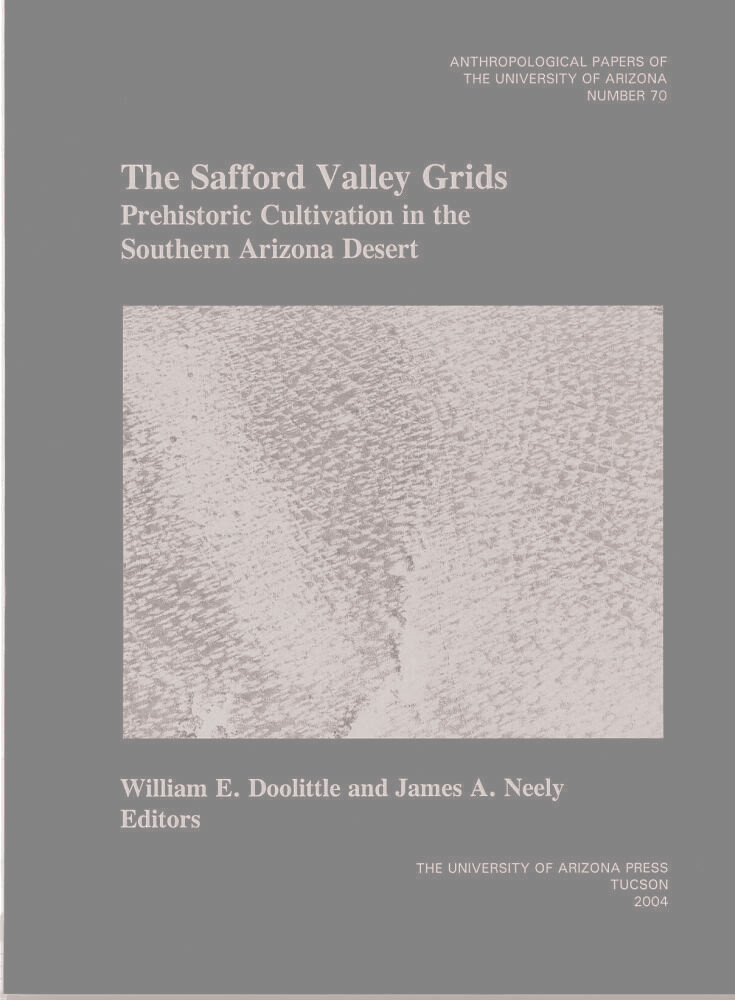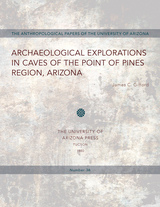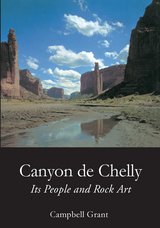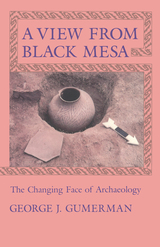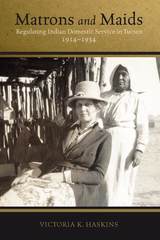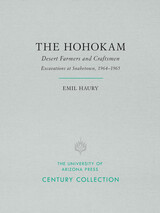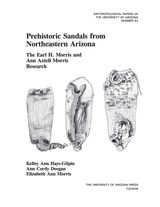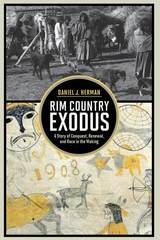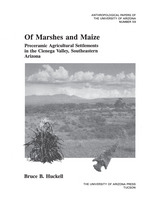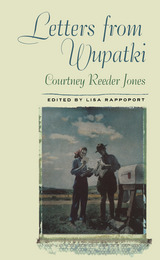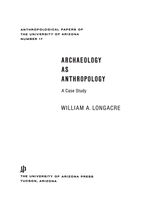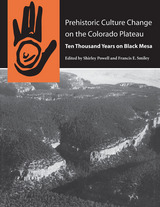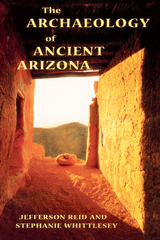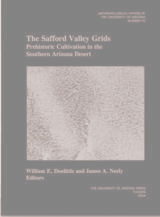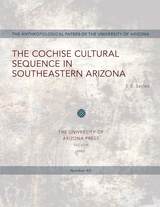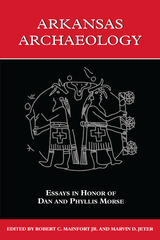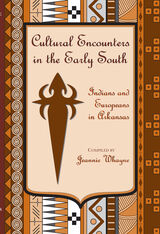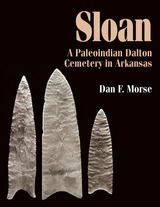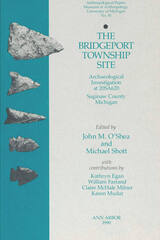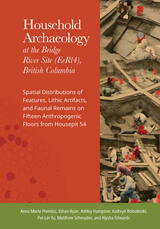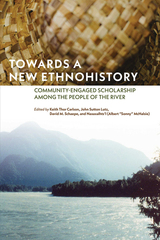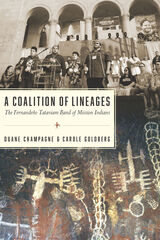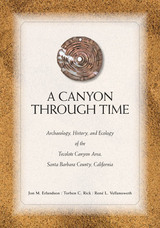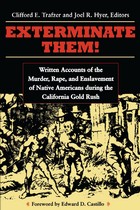The Safford Valley Grids: Prehistoric Cultivation in the Southern Arizona Desert
by William E. Doolittle and James A. Neely
University of Arizona Press, 2004
Paper: 978-0-8165-2428-0
Library of Congress Classification E78.A7S23 2004
Dewey Decimal Classification 979.15401
Paper: 978-0-8165-2428-0
Library of Congress Classification E78.A7S23 2004
Dewey Decimal Classification 979.15401
ABOUT THIS BOOK | AUTHOR BIOGRAPHY | TOC
ABOUT THIS BOOK
Crisscrossing Pleistocene terrace tops and overlooking the Gila River in southeastern Arizona are acres and acres of rock alignments that have perplexed archaeologists for a century. Well known but poorly understood, these features have long been considered agricultural, but exactly what was cultivated, how, and why remained a mystery. Now we know. Drawing on the talents of a team of scholars representing various disciplines, including geology, soil science, remote sensing, geographical information sciences (GISc), hydrology, botany, palynology, and archaeology, the editors of this volume explain when and why the grids were built.
Between A.D. 750 and 1385, people gathered rocks from the tops of the terraces and rearranged them in grids of varying size and shape, averaging about 4 meters to 5 meters square. The grids captured rainfall and water accumulated under the rocks forming the grids. Agave was planted among the rocks, providing a dietary supplement to the maize and beans that were irrigated on the nearby bottom land, a survival crop when the staple crops failed, and possibly a trade commodity when yields were high. Stunning photographs by Adriel Heisey convey the vastness of the grids across the landscape.
Between A.D. 750 and 1385, people gathered rocks from the tops of the terraces and rearranged them in grids of varying size and shape, averaging about 4 meters to 5 meters square. The grids captured rainfall and water accumulated under the rocks forming the grids. Agave was planted among the rocks, providing a dietary supplement to the maize and beans that were irrigated on the nearby bottom land, a survival crop when the staple crops failed, and possibly a trade commodity when yields were high. Stunning photographs by Adriel Heisey convey the vastness of the grids across the landscape.
AUTHOR BIOGRAPHY
William E. Doolittle is the Erich W. Zimmermann Regents Professor in Geography and the Chairman of the Department of Geography at The University of Texas at Austin and author of Cultivated Landscapes of Native North America. James A. Neely is Professor Emeritus of Anthropology and Archaeology at The University of Texas at Austin and the author of several publications on water management and irrigation in the American Southwest, Pueblo and Oaxaca in Mexico, and the Deh Luran Plain of Iran.
TABLE OF CONTENTS
Contents
Preface xiii
Acknowledgments xiv
1. A Checkered Landscape 1
William E. Doolittle and James A. Neely
Grids, Grids, and More Grids 1
Waffle Gardens 1
Pebble-mulch Gardens 3
Rock-bordered Grids 5
The Safford Valley Grids 5
Previous Research 7
The Cast of Characters 7
Differing Interpretations 7
Consensus on Interpretation 8
The Grids are Not Alone 9
Other Evidence of Human Occupation 10
Additional Thoughts 10
1994 Reconnaissance 12
Addressing the Issues 12
Proposition of Age 12
Proposition of Construction 15
Proposition of Purpose 15
Proposition of Function 16
2. Paleoclimatic and Archaeological Contexts 18
James A. Neely
History of Climate from
150 B.C. to A.D. 1450 18
Early Formative Period 18
Late Formative Period 18
Classic Period 20
The Archaeological Perspective 20
Prehistoric Cultural Developments
in the Safford Valley 21
Paleoindian and Archaic Occupations 21
Early Formative Period 23
Late Formative 24
Classic Period 26
Findings and Meanings 30
3. Geologic Setting 31
Brenda B. Houser
Regional Geologic Setting 31
Local Stratigraphy 32
Upper Basin Fill 32
Gila River Alluvium on Terraces 33
Loess 34
Piedmont Alluvium 34
Gila River Alluvium of the
Floodplain and Channel 34
Geology of the Gila Mountains 34
Geology of the Southwest
Piedmont Slope 36
Findings and Meanings 37
4. Landscape Context: Gis Analysis and Mapping 38
Dale R. Lightfoot
Aerial Photography and Mapping 38
GIS Analysis 39
Measures of Area and Length 39
Association with Soils 42
Association with Geology 42
A Symmetry of Pattern: Big
Spring Wash as Central Place 44
Findings and Meanings 46
5. Site Topography and Hydrology 48
William E. Doolittle
Terraces 48
Grids 54
Findings and Meanings 60
6. Soil Investigations 62
Jeffrey A. Homburg, Jonathan A. Sandor,
and Dale R. Lightfoot
Methods 62
Soil Mapping Data 64
Previous Soil Testing Data 65
Review of Soil Tests 65
Soil Morphological Properties and
Their Agricultural Implications 67
Physical and Chemical Soil
Testing Data 69
Granulometric Tests 76
Soil Moisture: The Cobble-Mulch Effect 77
Findings and Meanings 78
7. Growing Conditions and Crops: the Field Evidence 79
Suzanne K. Fish, Paul R. Fish, Arthur
MacWilliams, Guadalupe S nchez de
Carpenter, and Karen R. Adams
Modern Vegetation Responses 79
Pollen Analysis 83
Roasting Pits 87
Reconnaissance 87
Excavations 88
Plant Remains 88
Dating 89
Artifact Collections 90
Magnitude of Production 92
Findings and Meanings 93
8. Archaeological Perspective 95
James A. Neely
The Rock-bordered Grids 95
Big Spring Wash and Vicinity 95
Boundary Markers Among the
Grids and Terraces 96
Features and Structures 97
Roasting Pits among the Grids 97
Rock Mound Feature 1 98
Structures 98
Excavation of Field House
Structure 1 105
The Artifacts 107
Ceramics 107
Flaked Stone 110
Ground Stone 110
Hand-held Stone Hoes 110
Tabular Knives 110
Findings and Meanings 111
9. Rock Art 112
Betty Graham Lee and William E. Doolittle
Sites and Localities 112
Methodology 113
Assessment of Conditions 115
Interpretations 115
Shrines 116
Water 117
Trade 117
Disclaimers 122
Cultures and Dates 123
Findings and Meanings 124
10. Answers and Ideas 125
James A. Neely and William E. Doolittle
Age 125
Construction 125
Purpose 126
Function 126
Labor Inputs 127
Production 127
Agave without Grids 127
The Role of Grids in the
Prehistoric Safford Valley 128
Archaeological Findings and the
Central Place Designation 128
Cultivation, Processing, and
Uses of Agave 128
The Role of Agave in the Mixed
Subsistence System 130
Rock-bordered Grid Fields and
Settlement Pattern 131
Chronological Placement of
Site AZ CC:1:2 (ASM) 132
Discussion of the Chronological
Placements 134
A Reconstructed History of
Site AZ CC:1:2 (ASM) 135
Social Organization Implications
at Site AZ CC:1:2 (ASM) 136
Comparison of AZ CC:1:2 (ASM) with
Other Agricultural Field Sites 137
General Observations 140
Afterthoughts 140
Appendix A: Soil Profile Descriptions 143
Jonathan A. Sandor and Jeffrey A. Homburg
Profile Description 1 143
Profile Description 2 144
Profile Description 3 145
Profile Description 4 145
Profile Description 5 146
Profile Description 6 146
Appendix B: Microscopic Analysis of a
Tabular Knife 149
Marilyn Shoberg
Findings and Meanings 151
References 153
Index
Figures
1.1. Waffle gardens at Zuni Pueblo, about 1910 2
1.2. One of only two waffle gardens remaining
at Zuni Pueblo in 1988 3
1.3.A pebble-mulch grid field on a Pleistocene
terrace overlooking the Rio Chama, New
Mexico 4
1.4. A subdivided pebble-mulch grid field in
the Chama Valley, New Mexico 4
1.5. The Safford Valley, showing locations
of site AZ CC:1:2 (ASM), and various
physical and cultural features 6
1.6. Map of site AZ CC:1:2 (ASM), grid
localities, and other cultural and
physical features 11
1.7. Grids with large rocks at Locality 4 13
1.8. Grids at Locality 5 13
1.9 Grids at Locality 6 13
1.10. Grids at Locality 2, with a rock
pile in the center of one grid 13
1.11. Long rock alignment ("diversion dam")
at Locality 6 13
1.12.Short rock alignment ("checkdam") at
Locality 1 13
1.13. An upslope view of terraces at Locality 1 14
1.14 A rock pile field adjacent to rock-
bordered grids at Locality 1 14
1.15. Schematic diagram of grid-to-terrace
transition at Locality 4 14
1.16. Upturned boulder with distinct variations
in patina from one side to the other 15
1.17. Undisturbed or in situ boulder with
distinct variations in patina from
top to bottom 15
1.18. Small rock "ring" at Locality 1 15
2.1. The Safford Valley showing its
geographic relationship to
neighboring archaeological areas 19
2.2. Chronology and phase sequence for the
later occupations of the Safford Valley
and adjacent regions 22
3.1. Simplified geologic map of the Safford
Valley and Gila Mountains showing
locations of rock-bordered grids 32
3.2. Partial map of geologic contacts
in part of the area of rock-
bordered grids 33
3.3. Fine-grained fluvial facies of upper
basin fill 34
3.4. Gila River terrace alluvium capped
by a lenticular loess deposit 35
3.5. Pebbly Gila River terrace alluvium
overlain by loess that is overlain
by piedmont alluvium 35
3.6. Loess deposit showing root casts
and paleosol horizons 36
3.7. Pebbly Gila River terrace alluvium
overlain by loess that is overlain
by piedmont alluvium 37
4.1. Rock-bordered grids and associated
ancient and present-day landscape
features 40-41
4.2. Map showing association between
rock-bordered grids and soils 43
4.3. Map showing association between
rock-bordered grids and geology 44
4.4. Buffer analysis map showing areas of
rock-bordered grids associated with
corridors set at 0.5 km, 0.5-1 km,
and 1.0-1.5 km on either side of Big
Spring Wash 45
4.5. Graph of symmetrical diminution of
rock-bordered grids with distance
east and west of Big Spring Wash 46
5.1. An uncleared and unterraced
portion of a slope 48
5.2. View from the base toward the top
of the terraced slope 49
5.3. Profile of the terraced slope 49
5.4. Close-up view, up slope, of intact
terrace alignments 50
5.5. Close-up view along a terrace
alignment 51
5.6. Close-up view of Terrace 6
after excavation 51
5.7. Profile of Terraces 5, 6, and 7 51
5.8. View down the terraced slope, showing
both risers and cross walls 52
5.9. View up the terraced slope, showing
possible boundary markers 52
5.10. Rock-bordered grids on an apparently
flat surface 55
5.11. Rock-bordered grids on a surface that
slopes more than is first perceptible 55
5.12. Plan of the rock-bordered grids at the
eastern edge of Locality 1 56
5.13. Plan of rock-bordered grids at the
eastern edge of Locality 1, with arrows
showing the directions of surface
gradients and hence runoff 57
6.1. Aerial photograph of Locality 1, showing
the locations of soil testing shovel
pits, trenches, and prospectors' pits 63
6.2. Thick petrocalcic horizon exposed in
Prospector Pit 1 68
6.3. Shallow petrocalcic horizon below terraces
and rock alignments in Trench 1 68
6.4. Argillic horizon in prospectors' pit 2,
surrounded by desert pavement 68
6.5. Histograms of soil data by sample
context 71
7.l. Herbaceous annual plants growing more
profusely in a rock grid border than in
a grid interior at Locality 1 80
7.2. Herbaceous annual plants blooming in a
rock pile but not in surrounding rock-
free areas at Locality 1 80
7.3. Creosote bush growing on and between
rock-bordered grids in December 1960 81
7.4. Creosote bush growing on and between
rock-bordered grids in March 1997 81
7.5. Oblique aerial photograph of Locality 4,
showing creosote bush growing on grid
borders rather than in grid interiors 82
7.6. Plan and excavation profile of
Roasting Pit 1 88
7.7. Plan and excavation profile of
Roasting Pit 2 88
7.8. Plan and excavation profile of
Roasting Pit 3 89
7.9. Tabular knives from site
AZ CC:1:2 (ASM) 91
7.10. Core scrapers or pulping planes from
site AZ CC:1:2 (ASM) 91
8.1. Pit House Locality 1 and vicinity 96
8.2. Rock Mound Feature 1, possibly a shrine 98
8.3. Field House Structure 2 102
8.4. Plan of Field House Structure 1 102
8.5. Hand-held stone "hoe" or digging tool 110
9.1. Site AZ CC:1:20 (ASM), looking
northwest 113
9.2. Humpback flute player shrine at
Locality 4 118
9.3. Circles and lines, possibly a solar motif 118
9.4. A serpent, possibly representing
flowing water 118
9.5. Geoglyph/petroglyph shrine at Locality 6 118
9.6. Concentric square and wavy line motif,
possibly representing a spring 118
9.7. Circles or spiral at site
AZ CC:1:20 (ASM) 118
9.8. Interlocking lines, possibly repre-
senting flowing water 119
9.9. An X motif, possibly an abstraction
for trade 119
9.10. Anthropomorph and pit and
groove motifs 119
9.11. Abstract curvilinear and
quadruped motifs 120
9.12. Sketch of same petroglyph
photographed in Figure 9.11 120
9.13. An X-shaped walking anthropomorph with
a load, possibly representing trade 120
9.14. Abstract curvilinear motif at site
AZ CC:1:20 (ASM) 120
9.15. Circles with lines, possibly an
abstraction for trade 120
9.16. Animal and spiral within circle motifs 120
9.17. Partial anthropomorph or a bird
in flight 121
9.18. Sketch of quadruped or rake motif
petroglyph 121
9.19. Abstract curvilinear and
anthropomorph motifs 121
9.20. Partial anthropomorph 122
10.1. Agaves on the north-facing upper
bajada slopes of the Pinaleño
Mountains 130
B.1. Tabular knife found near Field House
Structure 1, Locality 9, site
AZ CC:1:2 (ASM) 149
B.2. Photomicrograph of a smoothed,
polished point on the edge of
a tabular knife 150
B.3. Photomicrograph of linear strips of
reticulate polish parallel to the long
axis of a tabular knife 150
B.4. Photomicrograph of weakly developed
polish on the high spots of the
tool surface 150
B.5.Photomicrograph of smooth, pitted
polish on the surface of an
experimental prismatic blade
of Edwards chert 151
B.6.Photomicrograph of fine, linear
striations parallel to the long
axis of the tool 151
B.7. Photomicrograph of the opposite face
of the tool, showing similarly fine
striae oriented at a slightly oblique
angle to the long axis 151
Tables
5.1. Cross-section dimensions of terrace
alignments 50
5.2. Terrace surface gradients 53
5.3. Detailed terrace surface gradients 53
5.4. Cross-section dimensions of rock borders 56
5.5. Rock-bordered grid sizes 58
5.6. Topography and hydrology of
rock-bordered grids 59
6.1. Previous soil testing results obtained by
the University of Arizona 65
6.2. Soil Chemistry and bulk density data for
soil profiles 70
6.3. Particle-sizes by percent in sediments
of soil profiles 70
6.4. Soil chemistry and bulk density data
for grid features, terraces, rock
piles, and their control areas 72
6.5. Particle sizes by percent in sediments
of grid features, terraces, rock piles,
and their control areas 73
6.6. Means and standard deviations for
soil chemistry and bulk density tests 74
6.7. Means and standard deviations for
particle-size analysis 74
6.8 t-Test probabilities for pair-wise
comparisons of suspected cultivated
and uncultivated soils 74
6.9. Percent change in weight of rock
material within grids compared with
rock material outside of grids 76
6.10. Percent change in weight of rock material
in the 0-5 cm level compared with the
5-10 cm level within and outside of grids 77
6.11.Relative measures of moisture content
within and outside of grids 77
7.1.Comparison of creosote bush distribu-
tion on rock alignments and control
areas 82
7.2. Names of pollen taxa in samples 83
7.3.Values for major pollen taxa in
site AA CC:1:2 (ASM) 84-85
7.4. Minor taxa in pollen spectra 86
7.5. Comparison of weedy pollen types in
upper slope samples 86
7.6. Quantity of charred plant remains
from roasting pits 89
7.7. Radiocarbon dates of roasting pits 90
7.8. Comparison of artifact collections
from the Marana Community and rock-
bordered grids 90
7.9. Frequencies of formal stone tools from
Marana fields and rock-bordered grids 92
7.10. Comparison of production estimates for
site AZ CC:1:2 (ASM) and the Marana
fields 93
8.1.Lithics from Pit House Locality 1 and
Rock Mound Feature 1, surface 99
8.2. Ceramics from survey and excava-
tion at site AZ CC:1:2 (ASM) 100-101
8.3. Lithics from Field House Structure 1
and Structure 2 103
8.4.Lithics from Field House Structure 1 104
8.5. Dating of ceramic types 108
9.1. Descriptions of petroglyphs 114
9.2. Assessment of petroglyph boulder
conditions by site 115
10.1 Chronological placement of site
AZ CC:1:2 (ASM) 133
10.2. Comparison of selected prehistoric
field systems in southern Arizona 138-139
See other books on: Doolittle, William E. | Neely, James A. | Plant remains (Archaeology) | Rock gardens | Terracing
See other titles from University of Arizona Press
